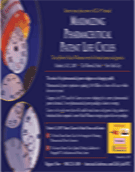The U.S. Court of Appeals for the Federal Circuit looked at the issue of whether Aventis committed that most horrible of patent sins — inequitable conduct before the United States Patent and Trademark Office (PTO). Aventis Pharma v. Amphastar and Teva (07-1280) .
Earlier, the CAFC held that the dosage of the prior art composition used in half-life comparisons with the patented composition was material to patentability but the court sent the case back to the district court to determine whether there was an intent to deceive by Aventis in failing to disclose the dosage.
The district court found that there was intent to deceive and held the patents unenforceable for inequitable conduct. Because Aventis didn’t like that answer, the case went back before the CAFC.
Aventis appealed a District Court summary judgment in favor of Amphastar Pharmaceuticals and Teva Pharmaceuticals that held U.S. Pat. No. 5,389,618 and Reissue Patent No. 38,743 unenforceable. The ’618 patent and the ’743 reissue patent disclose and claim mixtures of low molecular weight herapin (“LMWH”) used to prevent blood clots and sold as Lovenox® (enoxaparin sodium injection).
Initially, the patent examiner rejected the claims over several references, including European Patent 40,144, stating that each of the prior art references teaches sulfated heparinic admixtures within the molecular weight range of the claims and is considered to be inherently the same as the claimed admixtures.
In response, Aventis argued that EP ’144 does not expressly state that the mixture contains two types of polysaccharides, one with a MW less than 2,000 daltons and one with a MW greater than 8,000 daltons, nor does it state the number average/weight average MW ratio. Aventis also argued that the evidence in the specification rebuts inherency.
Based on methods of Example 6 by Dr. Uzan, Aventis argued that the claimed LMWHs exhibit a significantly longer half-life than formulations prepared in accordance with EP ’144. Aventis went on to explain that, because it is well established that compounds are inseparable from their properties, the evidence of a difference in a property, i.e., half-life, serves as evidence of a difference in structure.
The examiner also reiterated that the Patent and Trademark Office does not have facilities for testing and comparing various products, and where the prior art teaches a product which is identical or nearly identical to that claimed, it is incumbent upon the Applicant to convincingly demonstrate that the claimed product provides some unexpected or unobvious property not demonstrated by the prior art products.
In a first declaration, Dr. Uzan distinguished the claimed formulations from the formulations in EP ’144 and concluded that “the formulations of [EP ’144] are clearly outside the scope of the present invention.” In a second declaration, Dr. Uzan referenced five tables comprising the raw data from the half-life comparisons between the claimed compound and the EP ’144 compound, which tables were attached to the declaration. The mean half-life for the EP ’144 compound was taken from Table III, which did not mention the dosage.
On appeal, Aventis argued that the district court erred in finding materiality because if the dose information were material to patentability, the examiner would have requested it because: she was presented with half-life data that enabled her to compare various doses, Dr. Uzan informed the examiner that the half-life comparison was done at different doses, those of skill in the art frequently compare half-lives at different doses, and half-life is independent of dose.
The district court determined that the representation by Aventis that the patented compound had an improved half-life as compared to the EP ’144 compound was material to patentability because Aventis referred to the improved half-life at least four times during prosecution and the examiner ultimately allowed the ’618 patent application after the final representation that the difference in mean half-life was statistically significant. The court found a strong inference of intent to deceive because it could find no credible explanation for comparing half-lives at different doses and because comparisons at the same dose showed little difference in half-life.
On the second go-around up the appeal food chain, Aventis argued that the district court made two clearly erroneous findings of fact: (1) that the central question relating to patentability was compositional differences, and (2) that the purpose of Dr. Uzan’s half-life comparisons was to show compositional differences.
Aventis offered a new reasonsfor Dr. Uzan’s failure to disclose the dosage information in his half-life comparisons. According to Aventis, Dr. Uzan’s half-life comparisons were intended to show a difference in properties in response to the obviousness rejection under 35 U.S.C. § 103, not to demonstrate a compositional difference to address the anticipation rejection under 35 U.S.C. § 102, as the district court concluded.
The CAFC was totally unmoved by this stating:
We find nothing in the district court’s opinion to suggest that it did not recognize the existence of the obviousness rejection, or that it believed the anticipation rejection to be the only rejection of record. Indeed, several statements in the opinion clearly indicate that the court was aware of the obviousness rejection.
Aventis also tried arguing that the district court made a mistake in excluding evidence that comparison of half-lives at different doses (the “clinically relevant dose”) was the standard practice in the LMWH field. This was also a no-go:
We find no abuse of discretion by the court’s exclusion of the evidence. First, evidence of industry practice of clinically-relevant doses would only be pertinent if there was a finding that the half-life comparisons were used to address obviousness, and not anticipation, because Aventis has conceded that half-life comparisons must be at the same dose to show compositional differences. Here, however, the district court found, and we have affirmed, that the half-life comparisons were at least in part intended to show compositional differences to address the anticipation rejection.
Furthermore, the district court, after examining all of the evidence, found it simply incredible that Dr. Uzan selected the clinically relevant doses for his half-life comparisons.
Aventis tried several additional arguments focused on whether Dr. Uzan really had deceptive intent but the court just yawned through those and affirmed the lower court.
Judge Rader, dissenting, felt that the law should limit a finding of inequitable conduct (as he calls the “atomic bomb” remedy of unenforceability) to only the most extreme cases of fraud and deception:
In Kingsdown, this court clearly conveyed that the inequitable conduct was not a remedy for every mistake, blunder, or fault in the patent procurement process. Even mistakes that struck at the heart and integrity of the process—like repeatedly recopying and acquiring rights to a rejected claim—did not amount to inequitable conduct. Instead this court required “culpable” conduct supported by clear and convincing evidence of intent to deceive the USPTO. Halliburton Co. v. Schlumberger Tech. Corp., 925 F.2d 1435, 1443 (Fed. Cir. 1991) (citing Consol. Aluminum Corp. v. Foseco Int’l Ltd., 910 F.2d 804, 809 (Fed. Cir. 1990)). At the same time, it is hard to imagine a more material mistake than reasserting claims to rejected subject matter. Materiality of any undisclosed or misleading information, of course, is the other prong of an inequitable conduct analysis. Cargill, Inc. v. Canbra Foods, Ltd., 476 F.3d 1359, 1363 (Fed. Cir. 2007). In sum, Kingsdown properly made inequitable conduct a rare occurrence.





 Now is the time for pharmaceutical companies – both brand name and generic – to rethink patent strategies not only in terms of this impending economic reality, but also in terms of the dramatic changes to the patent landscape on every front – in Congress, at the PTO, and in the courts.
Now is the time for pharmaceutical companies – both brand name and generic – to rethink patent strategies not only in terms of this impending economic reality, but also in terms of the dramatic changes to the patent landscape on every front – in Congress, at the PTO, and in the courts.